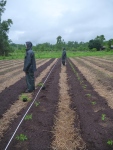The big start to our harvest season is set to begin in two weeks. On July 9 we will be providing our first CSA share to 25 members here at the farm. This season’s plantings have been later than usual, given the “from scratch” field we have been working with. Early on we knew we needed to allow ourselves additional time to prepare the beds and planting areas, so we decided on a “peak season” CSA, which will feed 25 families for 12 weeks from July 9 to September 24. Thus, our plants are seemingly smaller than our neighbors’, yet they are right on schedule for our own distribution goals.
So here’s the update two weeks out: The non-stop rain of the last few weeks brought out the slugs and snails, which quickly slid on the opportunity to munch on our bean leaves. For protection from the slugs we use wood ash, which we gather from our fire pit and fireplace. Neatly scattered around the base of the plants, the slugs do not like the feeling on their slippery bodies, therefore avoiding them henceforth. The cloudy skies also seemed to slow down the growth of some things, but this week’s sun has perked everything back up, and sent the plants into photosynthesis once again. The tomatoes, eggplant, and peppers are smiling at the sun, which is helping this late-planting of solanaceous crops better establish itself. While we are not on hands and knees thinning or weeding, or walking behind our Earthway Seeder planting more greens, we have been working on a few tertiary projects.
The outdoor shower! With all this heat we practically can’t wait for this project to be completed. On an old deck that the previous owner built about 50 ft from the house, we have built up privacy walls, made from old fence posts and planks, and are erecting a solar-powered shower. Small in capacity, we will hoist a 15 gallon water barrel atop a platform, which sits directly in afternoon sunlight. This barrel will then be simply plumbed to a garden hose, and after filling, will heat in the sun. So after a long and dirty day’s work, we can rinse off in the cool shade of this breezy platform.
We also are completing the signs for our finished farm stand. Our friend and artist Aidan, who is staying with us a few days a week to help out on the farm, is painting signs advertising our farm and stand. By mid-July we hope to have our self-service farm stand stocked daily with abundant produce, and look for cut flowers by late summer.
Lastly, here’s the sneak preview of what’s to come in the first few weeks of our CSA. Turnips, radishes (2 types), beets (4 types), arugula, rainbow pac choy, lettuce mix, baby Red Russian kale, baby mustard greens, spinach, and possibly cilantro and endive.


















